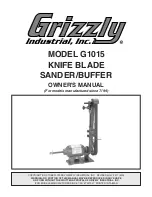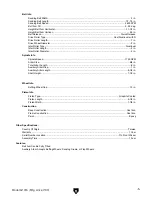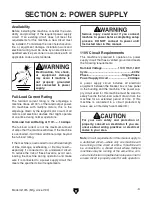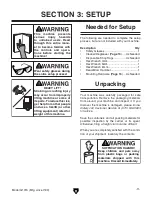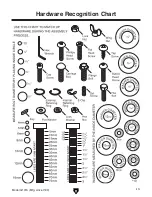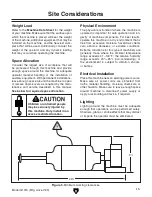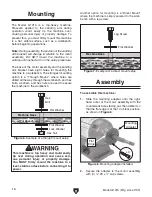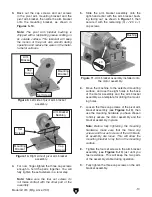
-8-
Model G1015 (Mfg. since 7/99)
Serious injury or death can occur from fingers, clothing, jewelry, or hair getting entangled in
rotating disc, belt, spindle or other moving components. Abrasion injuries can occur from
touching moving sandpaper with bare skin. Workpieces thrown by sanding surface can strike
operator or bystanders with moderate force, causing impact injuries. Long-term respiratory
damage can occur from using sander without proper use of a respirator. To reduce the risk of
these hazards, operator or bystanders MUST completely heed the hazards and warnings below.
WORKPIECE INSPECTION. Nails, staples, knots,
or other imperfections in workpiece can be dis-
lodged and thrown from sander at a high rate of
speed at people, or cause damage to sandpaper
or sander. Never sand stock that has embedded
foreign objects or questionable imperfections.
SANDPAPER CONDITION. Worn or damaged
sandpaper can fly apart and throw debris at
operator, or aggressively grab workpiece, result-
ing in subsequent injuries from operator loss
of workpiece control. Always inspect sandpaper
before operation and replace if worn or damaged.
IN-RUNNING NIP POINTS. The gap between
moving sandpaper and fixed table/support cre-
ates a pinch point for fingers or workpieces; the
larger this gap is, the greater the risk of fingers or
workpieces getting caught in it. Minimize this risk
by adjusting table/support to no more than
1
⁄
16
”
away from sandpaper. For spindle sanders, always
use the table insert that fits closest diameter of
installed drum.
MINIMUM STOCK DIMENSION. Small workpieces
can be aggressively pulled from your hands, caus-
ing contact with sanding surface. Always use a
jig or other holding device when sanding small
workpieces, and keep hands and fingers at least
2” away from sanding surface.
WORKPIECE INTEGRITY. Sanding fragile
workpieces can result in loss of control, resulting
in abrasion injuries, impact injuries, or damage
to sandpaper. Only sand solid workpieces that
can withstand power sanding forces. Make sure
workpiece shape is properly supported; avoid
sanding workpieces without flat bottom surfaces
unless some type of jig is used to maintain support
and control when sanding force is applied.
SANDPAPER DIRECTION. Feeding workpiece
incorrectly can cause it to be thrown from machine,
striking operator or bystanders, or causing your
hands to slip into the moving sandpaper. To reduce
these risks, only sand against direction of sandpa-
per travel, ensure workpiece is properly supported,
and avoid introducing sharp edges into moving
sandpaper on the leading side of the workpiece.
HAND PLACEMENT. Rotating sandpaper can
remove a large amount of flesh quickly. Always
keep hands away from sandpaper during opera-
tion. Never touch moving sandpaper on purpose.
Use a brush to clean table of sawdust and chips.
FEEDING WORKPIECE. Forcefully jamming
workpiece into sanding surface could cause it to
be grabbed aggressively, pulling hands into sand-
ing surface. Firmly grasp workpiece in both hands
and ease it into sandpaper using light pressure.
AVOIDING ENTANGLEMENT. Becoming entan-
gled in moving parts can cause pinching and
crushing injuries. To avoid these hazards, keep all
guards in place and closed. DO NOT wear loose
clothing, gloves, or jewelry, and tie back long hair.
WORKPIECE SUPPORT. Workpiece kickback
can occur with violent force if workpiece is not
properly supported during operation. Always sand
with workpiece firmly against table or another sup-
port device.
SANDING DUST. Sanding creates large amounts
of dust that can lead to eye injury or respira-
tory illness. Reduce your risk by always wearing
approved eye and respiratory protection when
using sander. Never
operate without adequate
dust collection system in place and running.
However, dust collection is not a substitute for
using a respirator.
Additional Safety for Sander/Buffers
Содержание G1015
Страница 15: ...Model G1015 Mfg since 7 99 13 5mm Hardware Recognition Chart...
Страница 40: ......

